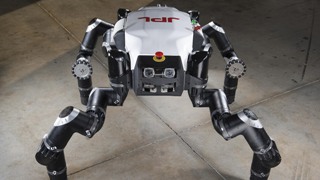May 29 2015
RoboSimian, the ape-like robot developed at NASA's Jet Propulsion Laboratory, Pasadena, California, will compete in the DARPA Robotics Challenge Finals at the Fairplex in Pomona, California, June 5 and 6.
 The Jet Propulsion Laboratory's official entry, RoboSimian, as it awaited the first event at the DARPA Robotics Challenge in December 2013, created to develop ground robots that can work in dangerous, degraded, human-engineered environments. Also known as "Clyde," the robot is four-footed but can also stand on two feet. It has four general-purpose limbs and hands capable of mobility and manipulation.
The Jet Propulsion Laboratory's official entry, RoboSimian, as it awaited the first event at the DARPA Robotics Challenge in December 2013, created to develop ground robots that can work in dangerous, degraded, human-engineered environments. Also known as "Clyde," the robot is four-footed but can also stand on two feet. It has four general-purpose limbs and hands capable of mobility and manipulation.
During the two-day competition, which is open to the public and free for spectators, robots will compete simultaneously across four different courses during hour-long runs. In addition to participating in the tournament, JPL will have a booth at an on-site robotics exposition, joining about 70 groups showcasing technologies relating to disaster response, robotics and unmanned systems.
With seven sets of stereo cameras for seeing and four limbs for maneuvering and manipulation, RoboSimian has been designed to traverse complicated terrain and perform dexterous tasks. The robot also features a LiDAR (Light Detection and Ranging) device for mapping its environment in 3-D. RoboSimian and its competitors will be faced with such tasks as driving a vehicle and getting out of it, opening a door, cutting a hole in a wall, opening a valve and crossing a field of debris.
The DRC Finals are the culmination of a three-year program to develop robots capable of assisting humans in responding to natural and man-made disasters. It was launched following the 2011 earthquake and tsunami that devastated the T?hoku region of Japan, with the goal of better preparing humans to confront the threats posed by future disasters. Through two preliminary rounds of competition, DARPA and the DRC teams have redefined what is possible in supervised autonomy, physical adaptability and human-machine control interfaces. Teams will vie for a first prize of $2 million.
The RoboSimian team at JPL is collaborating with partners at the University of California, Santa Barbara, and the California Institute of Technology in Pasadena. Caltech manages JPL for NASA.